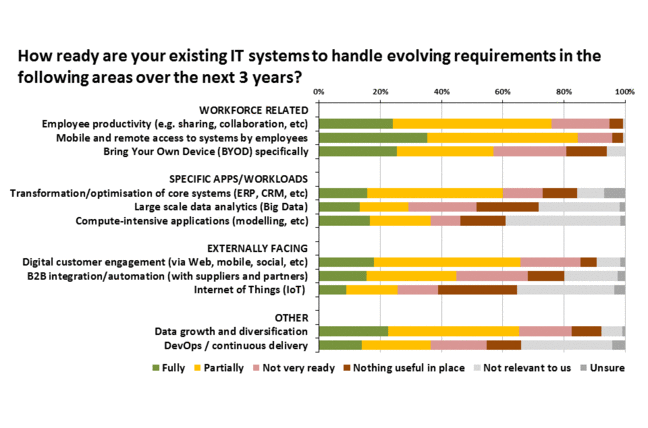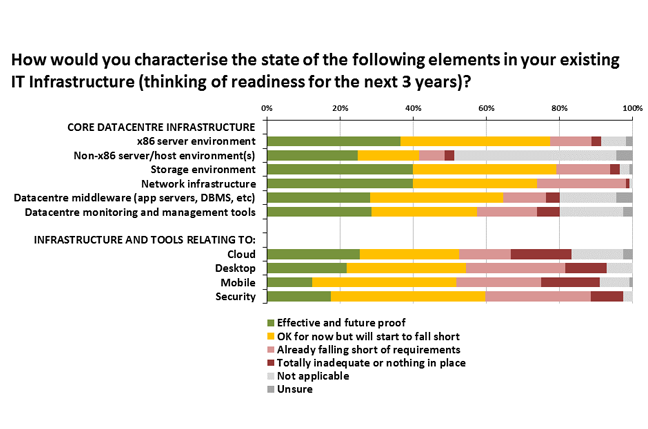This article is more than 1 year old
Infrastructure Readiness? It's time to get realistic
How future proof are your IT systems?
Temperature Check Many IT professionals believe their IT infrastructures are coping pretty well with current business requirements, but they are also aware that new and changing needs will lead to future capability gaps, if they are not doing so already. They also know that doing more of the same is not the answer in many areas. New architectures and delivery models will be necessary to effectively keep pace with evolving demands.
Mind the gap
Marketing people and pundits like to tell tales about how IT teams are generally failing to deliver. If you took everything you read on face value, you could easily get the impression that IT systems and infrastructures in most businesses were totally unfit for purpose. It’s a nice line for those trying to sell you stuff, but it doesn’t really help you understand where you are and where it really makes sense to focus your improvement efforts.
The truth is that every organisation is different. Business requirements and pressures vary considerably, while the way in which your IT infrastructure has evolved over time will likely have put you in a different place to most of your peers and competitors. Given this, the chances are that you’re doing well in some areas, and not so well in others.
With this in mind, when you look at the results of our latest Reg reader temperature check survey on infrastructure readiness for the future (117 respondents), just think of it as a high-level guide to some of the things you might want to review when assessing your own position. This kind of reminder is useful because capability gaps have a tendency to open up over time without anyone noticing. The same goes for creeping inefficiency.
Readiness for evolving demands
Some aspects of the business served by IT change faster than others. During the survey we focused on the more dynamic areas, as these are the ones in which your current infrastructure may suffer stress, or struggle to provide what’s required, as requirements continue to evolve. Overall, the picture that emerged was pretty mixed from an infrastructure readiness perspective (Figure 1).

The above-mentioned variation comes through strongly as we can see. In each area, some report they are in good shape, others indicate they are partially ready but clearly have some work to do, and then we have those who are not very ready at all, or haven’t even started to tackle the problem. Take note also of the light grey bars indicating where the area concerned is not considered relevant.
Where would you place your own organisation in the areas listed?
Building on the right foundation?
Another question to consider is which specific parts of your infrastructure you regard to be future proof or otherwise - i.e. where are the strongest and weakest links. When it comes to core data centre infrastructure - servers, storage, networking, and so on - survey responses are still a bit mixed, but the overall picture is not too bad. However, more gaps are evident in relation to fast-moving areas such as cloud, desktop, mobile and security (Figure 2).

The data shown on the top part of this chart is consistent with a steady level of investment and modernisation to deal with ongoing requirements for more capacity and the desire to virtualise core resources as much as possible. Having said that, quite a few realise that the way they have been supporting demands for greater capacity, flexibility, responsiveness and efficiency to date are not sustainable going forwards.
The important point here is that continuing to extend systems based on traditional/familiar components and architectures only gets you so far. Older servers and storage devices, for example, tend to be more difficult to integrate, instrument, automate, scale and generally administer than more modern equivalents designed to work as good citizens in a dynamic infrastructure environment. In addition, older components tend to be less efficient from a price/performance, power efficiency and physical footprint perspective, which may or may not be an issue depending on your constraints with regard to budget, space, datacentre facilities, and so on.
If you are sitting on old kit, even though it’s meeting your needs for now, consider introducing the latest generations of equipment sooner rather than later to start future-proofing your environment. This doesn’t mean rip and replace (apart from the stuff that’s already constraining you or becoming a liability), it’s about making sure that new investments are made with tomorrow’s needs in mind rather than yesterday’s.
And if your response to this is that you don’t have a crystal ball to predict what business stakeholders and users are going to ask for in the future, you may need to adjust your mind-set.
